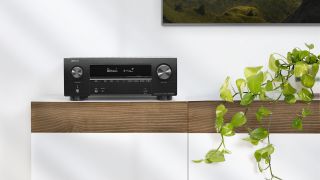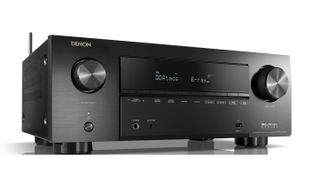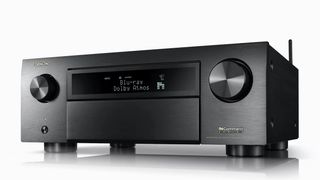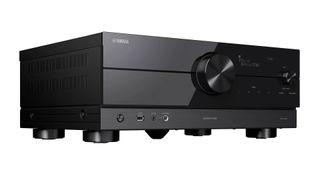Best AV receivers 2024: top amplifiers for your home theater
The best AV receivers to power your Atmos speaker system

Our AV receiver buying guide is dominated by Denon, a brand that’s known for incorporating the latest and greatest audio and video technologies in their models, including HDMI 2.1 ports and support for 8K passthrough. While other brands may support those features as well, a main spec you’ll want to look for is power output, and our choices here offer a range of total amplifier power to drive an Atmos speaker system.
With early Easter sales happening, there’s a good chance you’ll find any one of these models at a discount, so click on our deals links to find the best prices.
Al Griffin, Senior Editor – Home Entertainment
If you're after the best possible home theater experience, you're going to need one of the best AV receivers. These provide up to 11 channels – and in some case, more – of built-in amplification to power a Dolby Atmos speaker configuration and also serve as the system’s brains, taking audio data from a source (like, say, a game console, a streaming box, or a TV) along with moving video signals from them to your TV.
How well it can handle these multiple tasks and how compatible it is with the latest generation of AV technologies and formats are the main criteria for evaluating which AV receivers are deserving of a spot on our list of the best models.
Importantly, AV receivers (which are also known as AVRs) don’t just power 5.1.2 and more complex Dolby Atmos speaker setups. They also improve the sound of connected sources through digital signal processing (DSP). This can extend to advanced room correction that will make your system sound better by applying audio equalization that reduces interference caused by interactions between the speakers and the room itself.
This is essential, because you should not just think of the best AV receivers as the central hub that all your entertainment equipment will connect to and communicate with in order to bring you the best possible experience, but the best possible sound as well.
While 4K resolution has long been the de facto standard, 8K AV receivers are now also entering the market. That means if you own or you’re thinking of upgrading to an 8K TV, you might want to check out the 8K-capable AVRs from Denon or Yamaha, especially for use alongside the latest gaming consoles, like the PS5 or Xbox Series X. While actual 8K content is many years away from being widely available, it’s still a good idea to consider it as a future-proofing measure when shopping for an AVR.
The best AV receiver for most people

Denon AVR-X2700H
Specifications
Reasons to buy
Reasons to avoid
There's very little we can hold against the Denon AVR-X2700H, one of the world's first 8K receivers and the winner of a number of accolades. It's what we consider the best overall AV receiver in terms of what it offers for the money.
What Denon's entry-level 8K AVR brings to the table is an incredible feature set comprising of Variable Refresh Rate (VRR), Quick Frame Transport (QFT), and Auto Low Latency Mode (ALLM) on each of the HDMI-In ports, plus support for HDR10+, HDR10, HLG and Dolby Vision forms of HDR. For the exceptionally stringent viewers out there, the AVR-X2700H also supports IMAX Enhanced, too.
In terms of audio formats, Dolby Atmos Height Virtualization, Atmos, DTS:X and DTS Virtual:X are all present and accounted for, plus with eARC support, you don't have to juggle multiple remotes. Of course, if you want to go remote-free there is voice support for Alexa, Google Assistant and Siri-enabled devices, making it truly egalitarian. It's a futureproof AVR and a great value especially at under $1,000.
Read more: Denon AVR-X2700H revealed
Best budget AV receiver

Sony STR-DH790
Specifications
Reasons to buy
Reasons to avoid
The Sony STR-DH790 is the latest entry-level receiver from the Japanese electronics manufacturer. While it’s ostensibly a seven channel design (which means it can run in a 5.1.2 Dolby Atmos configuration) there are also two phantom rears which create a pseudo seven channel surround soundstage. The receiver can even virtually relocate the physical position of your speakers, to create a better sonic balance.
Build quality is commensurate with its price tag. This is no heavyweight, and the fascia looks overly fussy, but the hairline finish is a premium touch. Connectivity is good for the price. We get four HDMI inputs, all HDCP 2.2 enabled, and one output. There are also two analogue AV inputs, plus a pair of stereo phonos and two digital audio inputs.
The AVR connects via Ethernet or Wi-Fi, and Bluetooth with NFC for quick pairing, plus Airplay. The AVR also boasts Chromecast Built-in. That’s all the main wireless boxes ticked.
Setup is helped along by the latest iteration of Sony’s Auto Calibration software, which now features a 31-band graphic EQ and a stereo calibration microphone that adjusts phase, distance and level.
Usability is average. The receiver relies heavily on its UI, which is pretty but sometimes a little frustrating.
Overall, however, this is an innovative, exciting AV Dolby Atmos receiver. Consider it a brilliant value home cinema offering.
The best high-end AV receiver

Denon AVR-X6700H
Specifications
Reasons to buy
Reasons to avoid
For most cinephiles out there, the Denon AVR-X6700H is going to be the best AVR money can buy. Sure, there are more expensive amps out there with a few superfluous bells and whistles, but the AVR-X6700H gives you 140W-per-channel amplification with all the essentials you need to keep your speakers sounding great.
Like the lower-cost the AVR-X2700H, the higher-end model supports Dolby Atmos Height Virtualization, Atmos, DTS:X and DTS Virtual:X are all present and accounted for, plus with eARC support, but you can also add DTS:X Pro to that list, too.
On the visual side, the AVR-X6700H does 8K upscaling unlike anyone else right now, as well as HDCP 2.3, the highest format available that can play copy-prohibited content without a problem. For HDR support, all the main players are here: HDR10+, HDR10, HLG and Dolby Vision.
It's a rock-solid choice, and while it's expensive, it absolutely delivers exceptional clarity, soundstage and presence to your favorite films and music, and is pretty much the pinnacle of what you can expect from a cutting-edge AVR.
The best AV receiver for gaming

Yamaha RX-A2A AV receiver
Specifications
Reasons to buy
Reasons to avoid
We're waiting to do our own review of this AV powerhouse, but respected reviewers confirm that this new Yamaha is just as good as its specs suggest – provided, that is, you update it. Some key gaming features hadn't been implemented at launch, but if you download the updates via its app you get the full suite of next-gen gaming features including 4K 120Hz, VRR and ALLM. When we reported the upgrade earlier this year, we said it meant that "Yamaha's HDMI 2.1 AV receivers are now the ultimate TV upgrade for PS5 owners." There are more upgrades to come including Quick Media Switching and Quick Frame Transport support.
Yamaha has given its AV receivers an impressive redesign to make them look much more modern, and the RX-A2A looks more expensive than it actually is. The redesigned remote is excellent and much easier to use than before, and there's great format support including Apple Lossless (ALAC), WAV/FLAC/AIFF to 192Hz and playback from Tidal, Qobuz, Deezer and the obligatory Spotify. There's also AirPlay 2 and Bluetooth (SBC/AAC), Google Assistant and Alexa compatibility and tuners for both DAB+ and AM/FM.
But what matters most here is how it sounds, and the reviews are all very positive. The sound stage is impressively wide without losing precision, and the only time it really struggles is with some of the very low frequencies during very big crashes. Dialogue remains strong even in busy action scenes, something other AV receivers aren't so good at, and it's impressive with gaming soundtracks and with music generally.
Choosing your AV reciever
How to choose the best AV receiver for you
Why you can trust TechRadar
Looking for some Hi-Res audiophile speakers to go with your record player? Check out the best stereo speakers. Bored of your TV's lackluster audio? Try one of our best soundbars on for size.
If you need a speaker you can take everywhere, make sure you look at the best waterproof speakers.
For total control of your smart home, invest in one of the best smart speakers, which come with Google Assistant, Amazon Alexa, or Siri built-in.
If you have a 4K set-up at home, then you need to be on the lookout for a receiver that has a wealth of HDCP 2.2 compatible HDMI ports. If you want to get really high-tech with your set-up, and invest in multi-room streaming, you need to think about which wireless speaker system is best for you – Chromecast, Heos, or even Yamaha MusicCast. Even if that's not something you're interested in right now, it makes sense to future-proof your set-up.
For many people, Dolby Atmos will be the killer app. This 3D audio system is now the gold standard in immersive audio. It may be available on soundbars, but only an AV receiver offers true overhead Dolby Atmos audio.
All you'll need to do is decide if you want a seven or a nine-channel system. (However, that said, you may not need Dolby Atmos at all, in which case a standard 5.1 sound system will fill your surround sound needs nicely.)
Have we convinced you that you need an AV receiver yet? The next step is figuring out which is the right one for you and luckily we've got a big list of all the best AV receivers you can get your hands on today.
Original reporting in this article was by Steve May.
Q&A
Why do you need an AV receiver?
A good AV receiver is the heart of your home entertainment system. It decodes the surround sound in games, movies and increasingly music too, amplifying the audio and sending immersive sound to all of your speakers. It sends crisp HDR video to your TV and keeps its soundtrack in sync. And it makes it easy to manage even the most complex combination of TV streamers, games consoles and other entertainment devices, switching between them with a single button press (or if it's got a personal digital assistant in it, with a single command).
What is the difference between an AV receiver and a stereo receiver?
Both devices are designed to connect your home entertainment kit to your speakers, and typically include an amplifier to drive those speakers too. But stereo receivers are designed only for audio. That makes them ideal for hi-fi systems where you want to have different audio separates such as a vinyl record player, a CD player and maybe a network music streamer too. But their many joys don't include multimedia: these are audio-only devices.
An AV receiver is more complex, because it enables you to connect audiovisual devices: Blu-Ray players, games consoles, TV streaming devices and so on. Those devices connect via the receiver's HDMI ports, and AV receivers then connect to your TV with another HDMI connection.
Let's take a real world example: the Sony AV receiver in our front room. We have a CD player connected to it just like we would with a stereo receiver: it connects via RCA audio cables and when selected on the receiver, it plays through the connected speakers. But we also have a PlayStation 5, an Xbox and an Apple TV connected to it – and when we play games or watch movies on those, the AV receiver not only sends the audio to the speakers but sends the video to our TV too.
The other key difference between stereo receivers and AV receivers is that AV receivers tend to have built-in decoding for popular home entertainment standards such as Dolby Vision HDR and Dolby Atmos surround sound, and for more audio channels than just stereo: 5.1 surround sound, 7.1 surround sound or 7.1.2 surround sound, where the seven speakers and subwoofer are supplemented with two up-firing speakers to deliver 360-degree audio in games and movies.
Are AV receivers good for gaming?
Yes, especially if the AV receiver supports the key features of your console such as the Xbox Series S and Series X's Dolby Vision HDR and Dolby Atmos audio.
However, not all AV receivers have the features you might want. if you're buying an AV receiver for gaming it's important to pay close attention to the type of HDMI connectors the AV receiver has: for cutting-edge gaming you want HDMI 2.1 ports with support for 4K gaming at 120Hz so it can cope with the current and next generation of consoles. This is still relatively rare in AV receivers – as our guide to the best gaming TVs demonstrates, many TV manufacturers are currently way ahead of their AV divisions in bringing HDMI 2.1 to their devices.
- Want a cheaper audio solution? Try one of our best soundbars
Get daily insight, inspiration and deals in your inbox
Get the hottest deals available in your inbox plus news, reviews, opinion, analysis and more from the TechRadar team.

Al Griffin has been writing about and reviewing A/V tech since the days LaserDiscs roamed the earth, and was previously the editor of Sound & Vision magazine.
When not reviewing the latest and greatest gear or watching movies at home, he can usually be found out and about on a bike.
